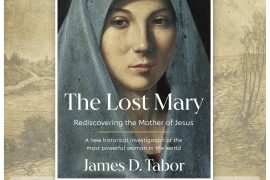Most people who read the New Testament read it “backwards.” By that I mean they begin with the four Gospels–Matthew, Mark, Luke, and John–move through Acts, and finally get to the letters of Paul and the rest. What many fail to realize is that the seven letters of Paul (1 Thessalonians, Galatians, 1-2 Corinthians, Romans, Philippians, and Philemon), of the thirteen attributed to him, are our first and earliest witnesses to the emerging Jesus movement. They were written in the 50s CE, with the Gospels and other N.T. documents coming 20-40 years later. [1]See my post on the “Quest for the Historical Paul” for more on how his letters and references to him in the book of Acts can be sorted out in terms of dating and historical reliability.
This issue of chronology and dating really becomes critical when one begins to investigate what we know of the resurrection “appearances” or “sightings” of Jesus following his crucifixion. Most everyone begins with the gospels. The evidence there is complex and quite mixed as to who saw what and when, but I think it can be sorted out, see my post “Why People are Confused About the Earliest Christian View of Resurrection of the Dead” as well as the related links here. What emerges, with some variation, is that beginning three days after Jesus’ death, Mary Magdalene and other women in her entourage, as well as Peter and those of the Twelve, as well as various disciples, encounter a “flesh and bones” Jesus, wounds and all, raised up out of the tomb in which he had been buried just before Passover. Although in one case two men who encountered him are “kept from recognizing him” for a short period, and he seems to appear and vanish in unexpected ways, he nonetheless eats meals with his followers, shows them his crucifixion wounds, and they touch him to satisfy themselves that they are not seeing a ghost or some apparition (Luke 24:36-42; John 21:9-11; Acts 1:3). Jesus, at least in Matthew, Luke, and John (as Mark has no appearances), is raised bodily from the dead–however his mode of existence might be enhanced or augmented. The gospels emphasize that the tomb is empty because the same body that was buried was “raised” the third day without experiencing “corruption.”
Accordingly, when people come to Paul, who provides us with the earliest testimony to Jesus’ resurrection, the assumption is that what Paul claims to have “seen” is the same kind of experience of the risen Jesus reported in our gospels. He clearly equates his own experience with that of James, Peter, and the other apostles, both in 1 Corinthians 9:1-2, where he defends his “apostleship” asking rhetorically–“Have I not seen Jesus our Lord?” as well as 1 Corinthians 15:5-8, where he recounts Jesus appearing to those before him, and concludes, using the same language, “Last of all, as to one untimely born, he appeared also to me.”
What this means is we should first ask “What did Paul claim to have seen?” when he testifies that he has “seen” the risen Jesus? If we can determine that, from his own descriptions of what was involved in Jesus’ resurrection, we can perhaps get an idea of what Peter, James, and the others likewise experienced–without just assuming the “appearances” they reported were those found in our later gospels–that is, a flesh and bones Jesus, walking out of his tomb, who eats meals, and invites his followers to touch him and examine his wounds.

Before you read on please get a Bible and read carefully 1 Corinthians 15:35-57. I could paste it into this post but I am going to ask that you read it afresh.
So what can we learn from Paul–what did he claim to have seen? First and foremost, he makes it clear that the resurrection “body” is not the physical, flesh and blood, mortal body that is buried in a tomb, but rather a transformed “spiritual” body, glorious, powerful, and immortal. For Paul, that is just what resurrection means–always. On this he is 100% consistent.
He expects that when Christ returns, both the living and those who have died, will be suddenly “metamorphosized” from “dust of the earth” to these new glorious bodies–just as Christ was raised from the dead. He makes it absolutely clear that what is to happen to the many–whether living or dead–at the return of Jesus, “in a moment, in the twinkling of an eye,” is precisely what happened to Jesus when he was raised from the dead. He was transformed from a “man of dust” with a body of weakness and corruption that he calls the “first Adam” to a “life-giving spirit” that he calls a “man from heaven,” or new second Adam. Jesus is the first-fruits of them that “sleep” in death, the “firstborn” of the dead. In Philippians he puts it like this: “He will change our lowly bodies to be like his glorious body” (3:20-21).
So one can only wonder and imagine, as the Corinthians did, what kind of a body emerges from this transformation–whether one is still alive in a mortal body, or long buried in the grave and turned to dust? Paul gives a clear answer–he says he has no idea. He even says it is foolish to speculate, as it is not something we can imagine. It is as different from our present bodies as a tiny seed is from a mighty tree. Bottom line: God gives all his creation “bodies,” which means “modes of existence,” appropriate to their place in the cosmos. So likewise those resurrected will be given glorified bodies that are indescribable, but appropriate to their exalted heavenly state.
So what did Paul claim to see when he says he has “seen the Lord Jesus.” The key word he uses repeatedly is “glory” or “splendor,” of such a degree that any glory ever experienced on earth–such as what Moses experienced at Sinai, is in comparison “no glory at all because of the glory that surpasses it” (2 Corinthians 3:10). The fact is he never describes what he saw or experienced–only that he knew it was the same Jesus as was crucified at Passover in 30 CE when he most likely was present in Jerusalem for the festival! In his mind he was absolutely persuaded that he had encountered Jesus. And it was through that encounter, and other subsequent experiences, such as his ascent to Paradise, that both his message and his mission were revealed to him. As he expresses it: “When it pleased God to reveal his Son to me…” (Galatians 1:16).
What comes to mind most readily is some kind of experience of a blinding light–brighter than even the sun–and a voice Paul recognized as that of Jesus. Interesting enough, that is precisely what the author of Luke-Acts reports. Most have dismissed Paul’s “conversion” narratives in the book of Acts as secondary and late compositions–and they might well be. But notice how the experience is consistently reported, three times:
Suddenly a light from heaven flashed about him. And he fell to the ground and heard a voice saying to him, “Saul, Saul, why do you persecute me?” And he said, “Who are you Lord?” And he said, “I am Jesus whom yo are persecuting…” (Acts 9:3-5)
…suddenly a great light from heaven shone about me and I fell to the ground and heard a voice… (Acts 22:6-7)
…at midday I saw on the way a light from heaven brighter than the sun, shining around me…(Acts 26:13)
What is notable here is that this sort of “blinding light” experience, coupled with a recognizable audible voice, would fit precisely with what Paul writes when he attempts to sketch out for the Corinthians and others what this glorious resurrection transformation is going to be like. It is bodily, but it is hardly flesh and blood, and it has nothing to do with reviving a physical corpse–since most of the dead are long turned to dust or ashes. Burials are symbolic locations of memory and loss, but even the “sea gives up the dead” in it according to Revelation 20:13, so there is no idea or interest in decaying bones or scattered ashes.
So if we go back full circle–why assume that the “flesh and blood” bodily appearances of Jesus recorded mainly in Luke and John, were in fact what Paul has in mind when he declares that Christ died, was buried, and was raised the third day–defining this as “the Gospel” (1 Corinthians 15:4)?
In this very chapter he defines this “raising” as a transformation from flesh to spirit–bodily yes–but indescribably so in terms of glory. Since he equates what he experienced–with that of the “appearances” to Peter, James and the other apostles, I think we can conclude from this our earliest account–that their experiences of the others were quite similar. After all, Paul had heard them firsthand from these very individuals whom he visited face-to-face in Jerusalem (Galatians 1:18-19). Since Paul writes in the 50s CE, and he clearly and without equivocation spells out in full detail, just what Jesus’ resurrection from the dead entailed, why assume the encounters of the other witnesses were different in kind from his? Resurrection does not have two meanings, one a revived physical corpse, the other a glorious transformation to a spiritual body. Paul is consistent in all his writings on this subject. Accordingly, Peter, James, and the others would have experienced individual and collective encounters with some kind of glorious presence, but with a familiar voice that they would have identified unmistakably as that of Jesus! Their testimony then was that he had been enthroned in heaven, at the right hand of God.
Bottom line, the earliest Christian view of Jesus’ resurrection from “among” the dead was that of his being crucified, buried, and then raised in a new glorious body to sit at the right hand of God. This is nothing like the reports of people coming out of tombs related by Matthew following Jesus’ crucifixion (Matthew 27:52). He says clearly that “many bodies of saints who had fallen asleep were raised and went into the holy city and appeared to many.” Notice, he uses the same language as he does for Jesus’ resurrection in the next chapter! Paul would have had no interest in such a report–even if he believed it, as clearly these “bodies” would have continued to grow old and die. They were not transformed to any kind of immortality!
The rotting corpse left behind is of no more interest to Paul than a suit of old clothes worn out and worthless–to use his own example in 2 Corinthians 5:1-5. One does not “remake” the old clothes, but casts them off, is naked for a time, with a “body,” but is then “reclothed” with garments of immortality and glory. That is Paul’s language and his description. It differs from Plato, who would consider the “naked” state, without the body, as ideal, as Socrates makes clear in the opening of the Phaedo. Paul, in contrast, says the Christian hope is not to become “naked,” escaping the body, but to be “reclothed.”
So if such is the case, why do we have these vastly differing alternative accounts in the gospels? First, it should be noted that Mark does not have any such revived corpse appearances. What the women are told in Mark is “you will see him in Galilee as he said,” hearkening back to Mark 9:1 where they experienced the transformed Jesus in blinding glory on the mountain–a proleptic view of the “kingdom of God coming with power.” So our earliest gospel ends up agreeing with Paul’s view, implicitly at least. Matthew is a bit unclear, as the epiphany of Jesus is also said to be on that particular mountain in Galilee, where Jesus had told them they would “see” him again. But Matthew does not really describe it in any detail, other than to say that some of even the Eleven apostles left, “doubted.”
Luke and John are the latest, and they are worried about critics of Christianity saying that what the disciples experienced was a ghost–some kind of apparition, but nothing provable beyond their individual experiences. This was a charge they faced for centuries to come–as we see with the critic Celsus, in the early third century, whom Origen counters. So the emphasis on “flesh and bones,” eating, and touching wounds, was an apologetic strategy to counter such naysayers. The claim would be that the apostles could not be “deluded” because they ate and drank with Jesus for forty days after he walked out of the tomb–identifying him positively with that same body that was crucified. Also, the appearances in Luke are all put in Jerusalem, nothing about a glorious vision on a mountain in the Galilee, as Mark and Matthew have things–Luke must stay as far away from that sort of thing as possible. But remember, that is our earliest gospel account! The tradition is clearly moving and evolving into one that the author of Luke-Acts could put forth into the Greco-Roman world and have what he hoped would be some degree of credibility. And John follows thereafter, with the same concerns, with “doubting Thomas” serving the role as the skeptic who becomes convinced by putting his finger in the actual wounds from the nails of crucifixion.
I can hear some of my critics saying–but wait, Jesus was first raised in the “same body,” and for forty days lived among the disciples–and only then ascended to heaven and attained the transformed body that Paul experienced. Unfortunately, that will just. not work. First, it is an invention of the author of Luke-Acts. Mark and Matthew say nothing of Jesus being taken to heaven after a period of being in his “earthly” body. And in John, Jesus is a “man from heaven” from the beginning, a descending and ascending Savior figure, which is an entirely different Christology. We need to go to Paul to be clear on the earliest view of Jesus’ resurrection and there is no ambiguity:
“What is sown is perishable, what is raised is imperishable; it is sown in dishonor, it is raised in glory; it is sown in weakness, it is raised in power; it is sown a physical body, it is raise a spiritual body.” (1 Corinthians 15:42-44).
I will close by saying that like Jesus, in another context, I think “no one after drinking old wine desires new; for he says, “The old is better” (Luke 5:39). In understanding the earliest view of Jesus’ resurrection I prefer our oldest source–that of Paul–and he remains our only eyewitness source, reported in the first person. That should be worth something to the historian. Whether one believes Paul experienced what he thought he experienced is entirely a separate issue. But what he claims seems to be to be clear. I prefer the old wine to the new.








Comments are closed.